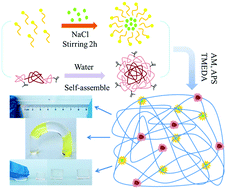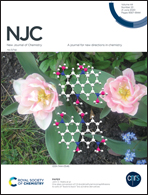Physically and chemically dual-crosslinked hydrogels with superior mechanical properties and self-healing behavior†
Abstract
An ideal hydrogel for biomedical engineering or flexible devices should have excellent properties, especially high stretchability, strength, resilience and self-healing ability to withstand cyclic loading and damage. The formation of hydrogels by physically and chemically dual-crosslinked structures is a powerful method to improve the strength and resilience. Here, we have designed a physically and chemically dual-crosslinked (PCDC) hydrogel with sodium dodecyl sulfate-stearyl methacrylate (SDS-C18) micelles as physical crosslinkers, amphiphilic polyether modified polysiloxane terminated by isocyanoethyl methacrylate (SiPU) nanoparticles as chemical crosslinkers, and acrylamide (AM) as the monomer. The prepared PCDC hydrogels have a tensile strength of more than 130 kPa and a tensile elongation at break value of over 710%, and can quickly recover their original state in cyclic tensile and cyclic compression tests, exhibiting excellent stretchability, strength and resilience. Based on the hydrophobic interaction mechanism, remarkable self-healing properties of the hydrogels were achieved, allowing re-adhesion of cut surfaces without any external stimulus.



 Please wait while we load your content...
Please wait while we load your content...